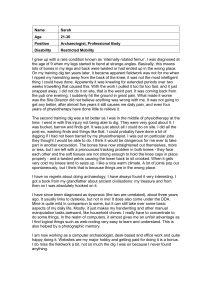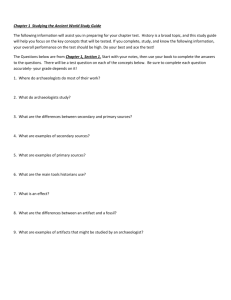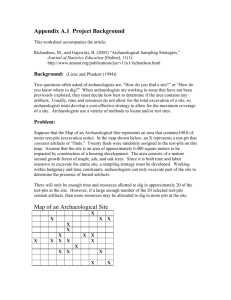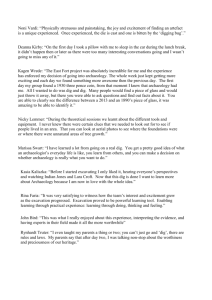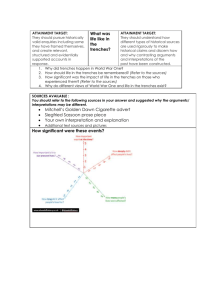EXCAVATION AND THE TRENCHES
advertisement
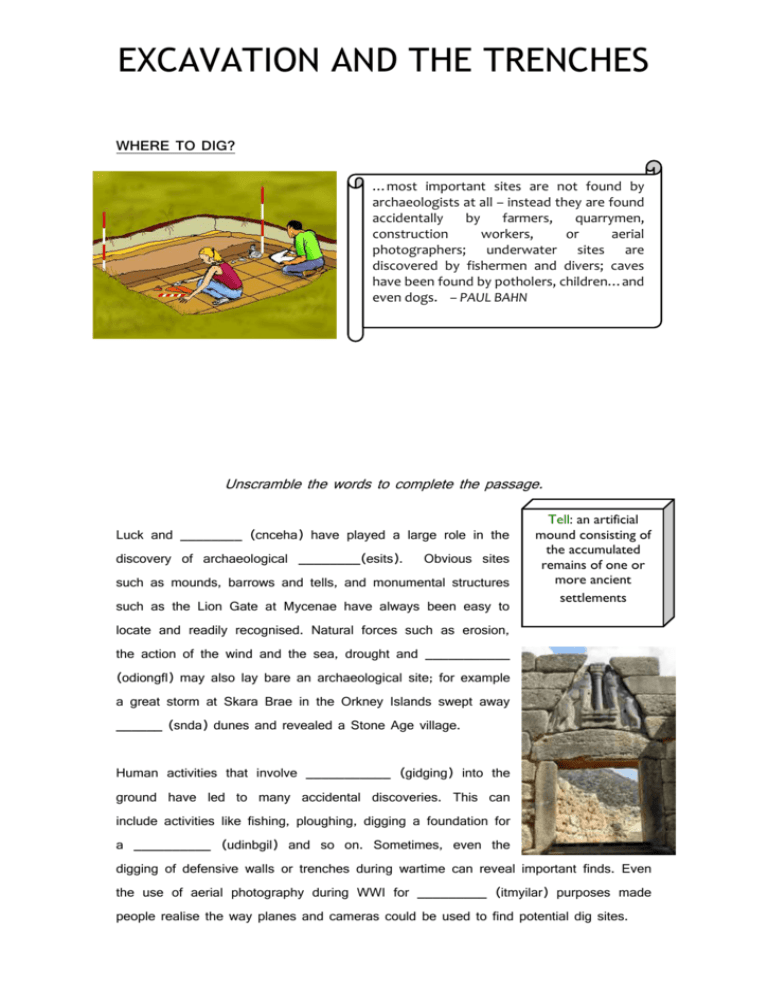
EXCAVATION AND THE TRENCHES WHERE TO DIG? …most important sites are not found by archaeologists at all – instead they are found accidentally by farmers, quarrymen, construction workers, or aerial photographers; underwater sites are discovered by fishermen and divers; caves have been found by potholers, children…and even dogs. – PAUL BAHN Unscramble the words to complete the passage. Luck and ________ (cnceha) have played a large role in the discovery of archaeological ________(esits). Obvious sites such as mounds, barrows and tells, and monumental structures such as the Lion Gate at Mycenae have always been easy to Tell: an artificial mound consisting of the accumulated remains of one or more ancient settlements locate and readily recognised. Natural forces such as erosion, the action of the wind and the sea, drought and ___________ (odiongfl) may also lay bare an archaeological site; for example a great storm at Skara Brae in the Orkney Islands swept away ______ (snda) dunes and revealed a Stone Age village. Human activities that involve ___________ (gidging) into the ground have led to many accidental discoveries. This can include activities like fishing, ploughing, digging a foundation for a __________ (udinbgil) and so on. Sometimes, even the digging of defensive walls or trenches during wartime can reveal important finds. Even the use of aerial photography during WWI for _________ (itmyilar) purposes made people realise the way planes and cameras could be used to find potential dig sites. Some sites are found using ________ (ciannet) literature. Heinrich Schliemann, using Homer’s epic poem, the Iliad, found Troy. He also used the writings of Pausanias, an ancient Greek _______ (avtrel) writer, to uncover a Grave Circle in Mycenae. Ancient maps, ________ (lendegs), folklore and place names all give clues to the archaeologist about what might once have existed and where it might be a good idea to dig. INTO THE TRENCHES A great deal of research and analysis is carried out before the exact site is _______ (osechn). A site plan is drawn up in consultation with a surveyor, and before the real excavation begins trial trenches are dug to select the _____ (esbt) place to dig. Sit Mortimer Wheeler, early in the 20th century, was the first archaeologist to use the BOX GRID system. Using this method, the site is _________ (idevdid) into squares or boxes of a given size. Each square is numbered and then excavated, leaving a wall (known as a BAULK) in between. Each baulk provides a vertical record of the layers that have been dug through; these ________ (yelars) are called strata and each one is labelled, as is everything found within them. Stratigraphy, which _________ (ilvesnvo) the study and interpretation of what has been deposited in the layers of the earth, is very important for dating finds. The grid system is not always used. Open area excavation is a_________ (thomed) by which the site is uncovered layer by layer from the top downward. In this method the different strata are not revealed. HOMEWORK (which you are no doubt very excited about): Use the internet and/or library to find out how one of the following was discovered and how luck/chance helped (write one paragraph): The Dead Sea Scrolls The Palace of Knossos The Mildenhall treasure ACTIVITIES A. Look at the line drawing on the previous page. Choose five different ‘characters’ in the picture and number them from 1 to 5. Then write down what you think that person is doing on the site and note any equipment they are using. 1) ___________________________________________________________ 2) ___________________________________________________________ 3) ___________________________________________________________ 4) ___________________________________________________________ 5) ___________________________________________________________ B. Explain what each of the following terms mean: Baulk: _______________________________________________________ Strata: _______________________________________________________ Box grid system: ______________________________________________ Aerial Photography: ____________________________________________ C. What kind of activities can lead to accidental discoveries? ___________________ ___________________________________________________________________ D. How do you think archaeologists use ancient literature to find sites? _____________________________________________________________________ _________________________________________________________________ COMPLETE YOUR HOMEWORK ON THE LINES BELOW _____________________________________________________________________ _________________________________________________________________ _____________________________________________________________________ _________________________________________________________________ _____________________________________________________________________ _________________________________________________________________ _____________________________________________________________________ _________________________________________________________________ _____________________________________________________________________ _________________________________________________________________ _____________________________________________________________________ _________________________________________________________________



